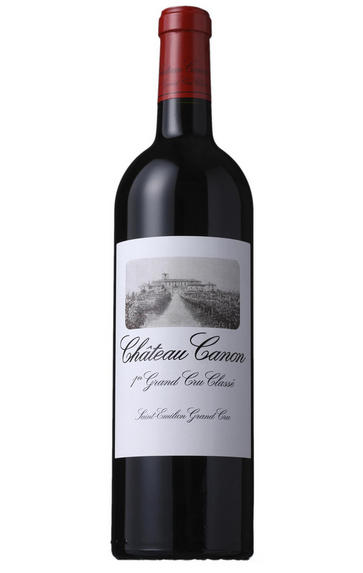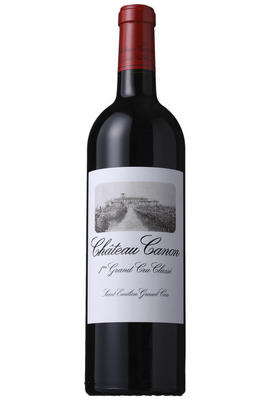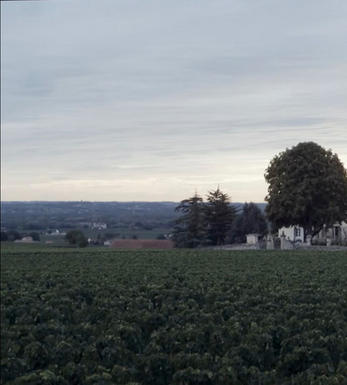
2017 Château Canon, St Emilion, Bordeaux

Critics reviews
Nicolas Audebert and his team have done it again. The 2017 Canon is shaping up to be one of the wines of the vintage. Rich and vertical in construction, the 2017 possesses off-the-charts richness and intensity in all dimensions.
The 2017 is sumptuous and layered in the glass, with superb detail and tons of sheer pedigree. In 20 years, readers will have a fabulous time tasting the 2015, 2016, 2017 and 2018 together and debating their respective merits.
Dark plum fruit, striking Franc aromatics and the clean, focused energy of Saint-Émilion's limestone plateau makes for a ravishing, exquisite wine of the highest level. In a word: breathtaking.
Drink 2027 - 2057
Antonio Galloni, Vinous.com (December 2019)
Tasted blind. Deep ruby colour. Layered nose with high tones of red fruit, flowers and vanilla bean, darker brambles, and incense. Very youthful fruit on the palate, which is round and full, finding notes of pencil shavings together with plush red fruit. The tannins are plentiful but ripe and soft, gently integrating into the fruit.
Drink 2027 - 2029
Tom Parker MW, JancisRobinson.com (October 2029)
Showing spectacularly, the 2017 Chateau Canon checks in as a final blend of 77% Merlot and 23% Cabernet Franc from one of the most exceptional terroirs in the appellation. Hitting 14% alcohol (the pH is 3.66) reveals a ruby/purple hue and gorgeously sweet raspberries and cassis-like fruit interwoven with notes of spring flowers, rose petals, white chocolate, and spice.
While it doesn’t have the massive opulence of the 2015 and 2016, it’s more classically styled and flawlessly balanced, with a terrific sense of minerality, ultra-fine tannins, and a brilliant finish. Give bottles 5-7 years in the cellar, which will evolve gracefully for 30-40 years.
Hats off to Nicolas Audebert and the team of Thomas Duclos for one of the vintage wines!
Drink 2025 - 2060
Jeb Dunnuck, JebDunnuck.com (December 2019)
About this WINE

Chateau Canon
Château Canon, a famous St.Emilion property is named after Jacques Kanon who bought the estate in 1760. Since 1996 it has been owned by Chanel, who also owns Château Rauzan-Ségla in Margaux.
Located in the centre of the St.Emilion appellation, to the south-west of St-Emilion town, Canon has 18 hectares of vineyards split between the limestone plateau and the clay/loam côtes. They are planted with 55% Merlot and 45% Cabernet Franc. Vinification is traditional: up to 20 days in temperature-controlled wooden vats followed by 18 months' maturation in oak barrels (70% new).
This wine needs cellaring to show at its best and mature Canon reeks of the soft, buttery Merlot grape as only the very top St-Emilions and Pomerols can. It is classified as a 1er Grand Cru Classé (B).

St Émilion
St Émilion is one of Bordeaux's largest producing appellations, producing more wine than Listrac, Moulis, St Estèphe, Pauillac, St Julien and Margaux put together. St Emilion has been producing wine for longer than the Médoc but its lack of accessibility to Bordeaux's port and market-restricted exports to mainland Europe meant the region initially did not enjoy the commercial success that funded the great châteaux of the Left Bank.
St Émilion itself is the prettiest of Bordeaux's wine towns, perched on top of the steep limestone slopes upon which many of the region's finest vineyards are situated. However, more than half of the appellation's vineyards lie on the plain between the town and the Dordogne River on sandy, alluvial soils with a sprinkling of gravel.
Further diversity is added by a small, complex gravel bed to the north-east of the region on the border with Pomerol. Atypically for St Émilion, this allows Cabernet Franc and, to a lesser extent, Cabernet Sauvignon to prosper and defines the personality of the great wines such as Ch. Cheval Blanc.
In the early 1990s there was an explosion of experimentation and evolution, leading to the rise of the garagistes, producers of deeply-concentrated wines made in very small quantities and offered at high prices. The appellation is also surrounded by four satellite appellations, Montagne, Lussac, Puisseguin and St. Georges, which enjoy a family similarity but not the complexity of the best wines.
St Émilion was first officially classified in 1954, and is the most meritocratic classification system in Bordeaux, as it is regularly amended. The most recent revision of the classification was in 2012

Merlot
The most widely planted grape in Bordeaux and a grape that has been on a relentless expansion drive throughout the world in the last decade. Merlot is adaptable to most soils and is relatively simple to cultivate. It is a vigorous naturally high yielding grape that requires savage pruning - over-cropped Merlot-based wines are dilute and bland. It is also vital to pick at optimum ripeness as Merlot can quickly lose its varietal characteristics if harvested overripe.
In St.Emilion and Pomerol it withstands the moist clay rich soils far better than Cabernet grapes, and at it best produces opulently rich, plummy clarets with succulent fruitcake-like nuances. Le Pin, Pétrus and Clinet are examples of hedonistically rich Merlot wines at their very best. It also plays a key supporting role in filling out the middle palate of the Cabernet-dominated wines of the Médoc and Graves.
Merlot is now grown in virtually all wine growing countries and is particularly successful in California, Chile and Northern Italy.


Buying options
Add to wishlist
Description
Nicolas Audebert and his team have done it again. The 2017 Canon is shaping up to be one of the wines of the vintage. Rich and vertical in construction, the 2017 possesses off-the-charts richness and intensity in all dimensions.
The 2017 is sumptuous and layered in the glass, with superb detail and tons of sheer pedigree. In 20 years, readers will have a fabulous time tasting the 2015, 2016, 2017 and 2018 together and debating their respective merits.
Dark plum fruit, striking Franc aromatics and the clean, focused energy of Saint-Émilion's limestone plateau makes for a ravishing, exquisite wine of the highest level. In a word: breathtaking.
Drink 2027 - 2057
Antonio Galloni, Vinous.com (December 2019)
wine at a glance
Delivery and quality guarantee